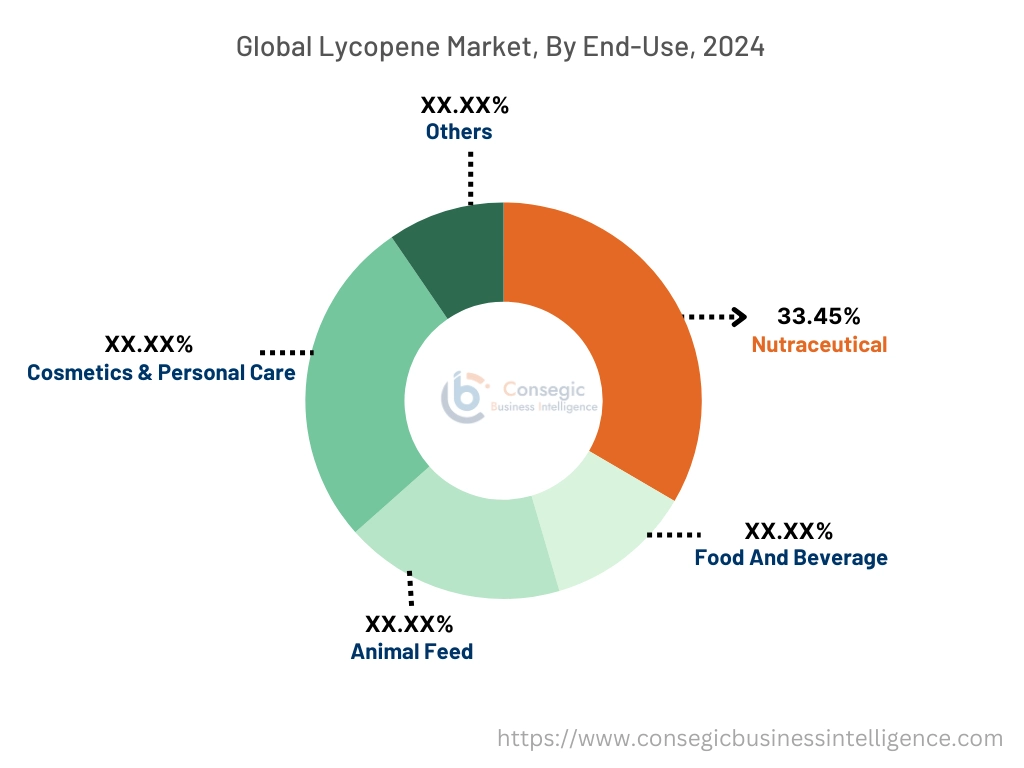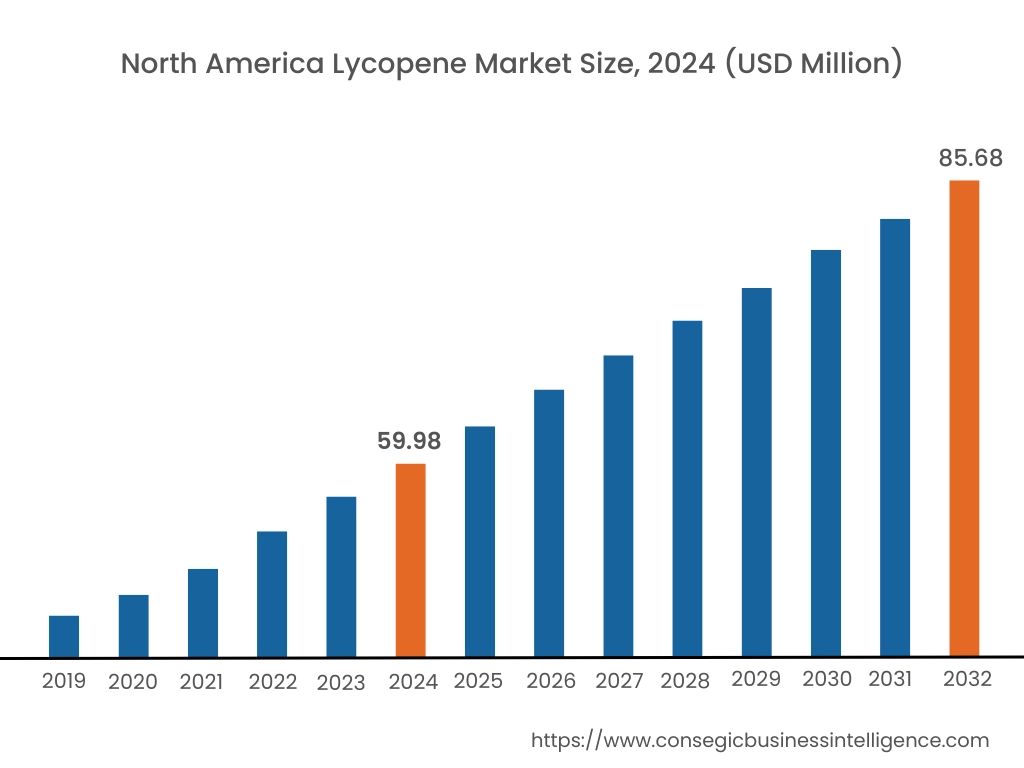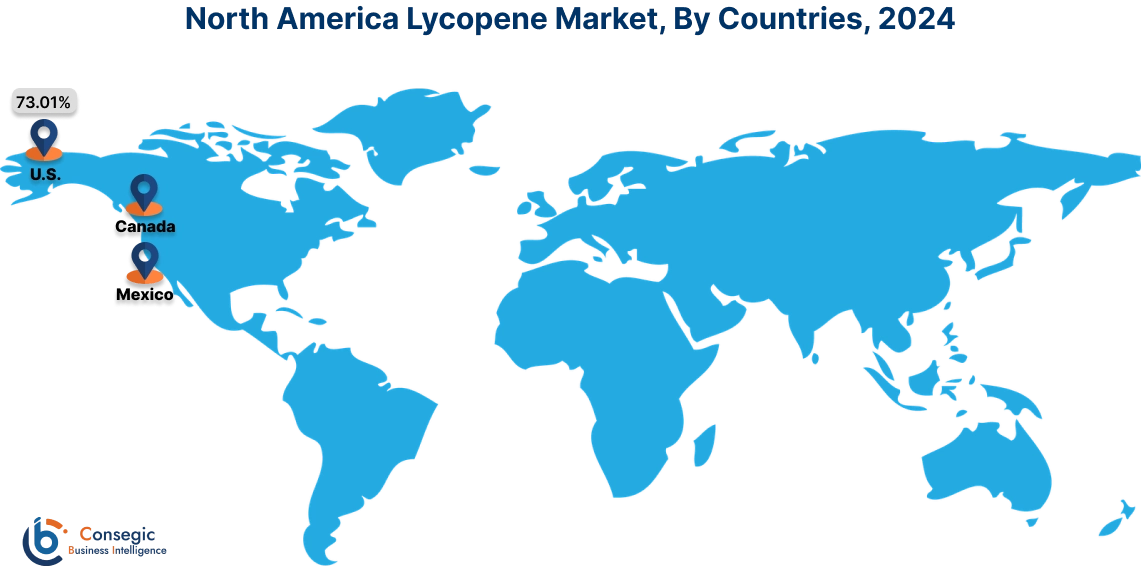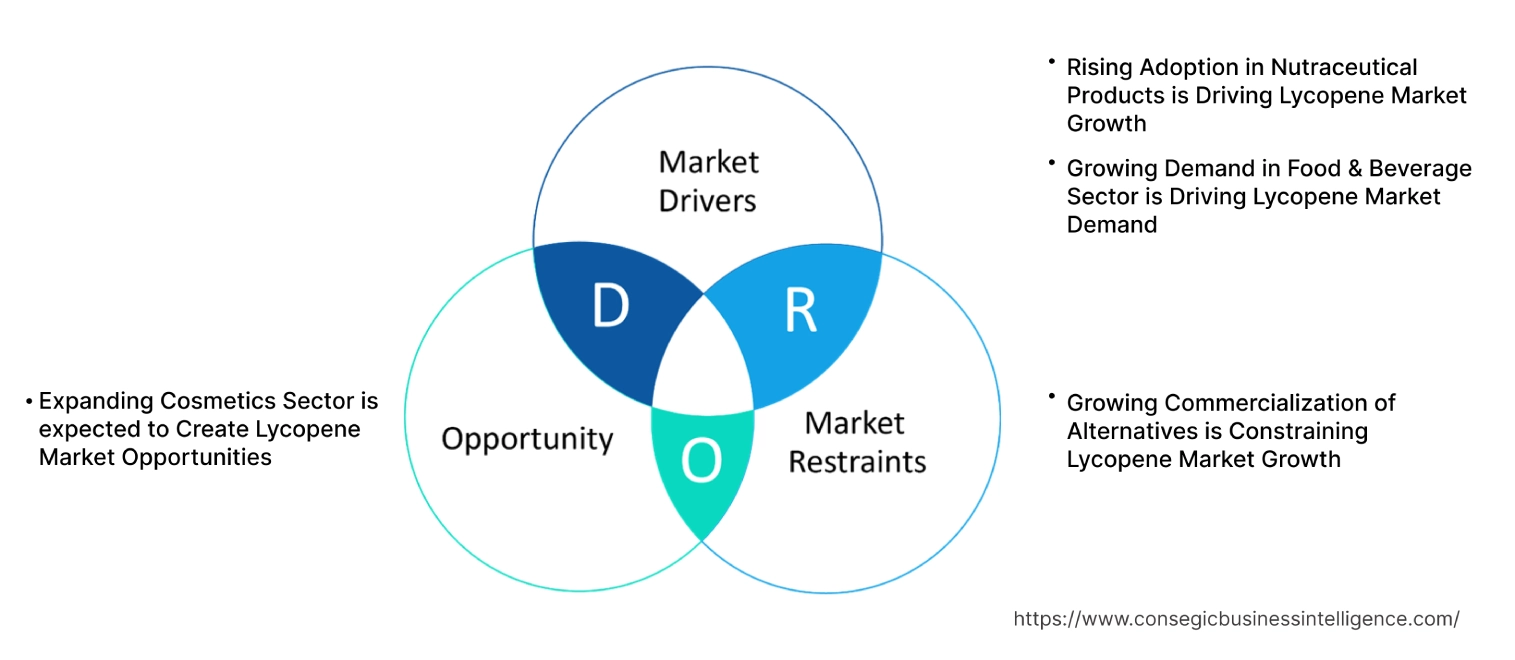- Summary
- Table Of Content
- Methodology
Lycopene Market Size:
The lycopene market size is growing with a CAGR of 5.1% during the forecast period (2025-2032), and the market is projected to be valued at USD 225.57 Million by 2032 from USD 152.03 Million in 2024. Additionally, the market value for the 2025 attributes to USD 159.25 Million.
Lycopene Market Scope & Overview:
Lycopene is a carotenoid compound found in tomatoes, watermelons, and pink guava. It is sourced through either natural or synthetic extraction processes. This compound is used in various applications such as dietary supplements, food processing, feed additive, cosmetic formulation, and others. It offers several advantages such as anti-oxidation, anti-bacterial properties, and protection against cellular damage. Due to these advantages, this compound is used in various sectors such as nutraceutical, food and beverage, animal feed, cosmetics & personal care, and others. The rising adoption of plant-based food products is leading to more use of natural coloring agents further driving the market growth.
Key Drivers:
Rising Adoption in Nutraceutical Products is Driving Lycopene Market Growth
Adoption of lycopene is growing in nutraceuticals products such as soft gels and powder. Companies are widely adopting this compound in their soft gels due to their inflammatory properties. The new range of these powders that are offered by the companies also contains this compound due to its nutritional properties. Moreover, companies are also incorporating this compound in their anti-aging nutraceuticals products.
- In 2024, Lycored launched Lycomato Beadlets. These beadlets contain lycopene to fight inflammation and oxidative stress. The reduction in cellular aging process and improvement in mitochondrial function is further boosting the adoption of this product.
Thus, rising adoption in nutraceutical products is leading to lycopene market expansion.
Growing Demand in Food & Beverage Sector is Driving Lycopene Market Demand
Lycopene compound is utilized in the food and beverage sector as a natural colorant and antioxidant in food products, offering a healthier alternative to synthetic additives. It is also utilized to preserve walnut oil, sunflower oil, and olive oil. The consumption of food and beverages is increasing due to the rising global population and increasing awareness of nutrition further driving the market.
- According to National Restaurant Association, the food and beverages sales is increased by 5.4% in United States in 2024 as compared to the year 2023. This growing consumption of food and beverages is driving in the use of this compound as a food colorant and preservative.
Hence, growing demand in the food and beverage sector is driving lycopene market demand.
Key Restraints:
Growing Commercialization of Alternatives is Constraining Lycopene Market Growth
The commercialization of alternatives such as beta-carotene, lutein, zeaxanthin amongst others is growing. They provide similar functions to that of lycopene. Beta-carotene is widely used in dietary supplements and functional foods due to its lower production costs and greater availability. Furthermore, lutein is preferred in skin care products such as moisturizers and cleansers due to better antioxidant and moisturizing properties, further reducing reliance. Additionally, zeaxanthin is used in animal feed for the coloration of chicken flesh and egg yolks and to improve nutrition in poultry. Hence, the growing commercialization of alternatives is constraining market growth due to low cost and greater availability.
Future Opportunities :
Expanding Cosmetics Sector is expected to Create Lycopene Market Opportunities
In cosmetics sector, lycopene is used in skin care products such as toners and cleansers due to its antibacterial properties. It is also utilized in the antiaging creams to reduce wrinkles and cellular damage. Further, the cosmetic sector is expanding due to rising disposable income, proliferation of E-commerce, and government support.
- In 2025, Estée Lauder partnered with Ministry of Commerce and Industry to expand cosmetic sector in India. This will lead to more consumption of skin care products such as toners and cleansers. This will create market opportunities due to the adoption in these products for anti-bacterial use.
Hence, expanding cosmetics sector is expected to create lycopene market opportunities.
Lycopene Market Segmental Analysis :
By Source:
Based on Source, the market is categorized into natural and synthetic.
Trends in Source
- The natural lycopene is widely used due to sustainable production and reduced chemical usage as per trends.
- Adoption of this compound derived from synthetic sources is growing in animal feed to improve health and performance of the poultry as per market trends.
The natural segment accounted for the largest market share in the year 2024.
- Lycopene compound is sourced naturally from red and pink fruits and vegetables such as tomatoes and red grapefruit. It is sourced through an eco-friendly and sustainable extraction process, reducing chemical usage.
- This compound is highly used in clean label cosmetic products to provide anti-inflammatory properties. It is also utilized in plant-based food products to enhance their antioxidant activity.
- Further, environmental concerns and ethical considerations related to animal welfare are growing. Due to this, consumers are preferring plant-based food products.
- According to Plant Based Foods Association, consumption of plant-based food products is increased by 16.4% in United States in 2023 from 2020. This growing preference for plant-based food products is further driving the use of this natural compound to enhance their antioxidant properties.
- Hence, as consumption of plant-based food products is growing, the need for natural lycopene is also increasing, in turn driving the segment.
The synthetic segment is expected to grow at the fastest CAGR over the forecast period.
- The lycopene compound derived from synthetic sources is an artificial compound derived from petroleum-based sources or microbial fermentation. It has superior consistency, stability and cost effectiveness.
- Due to these properties, it is increasingly used in dietary supplements and animal feed additives.
- Further, in animal feed it is used in animal production, particularly in poultry and swine to improve health and performance.
- Additionally, the advancements in feed technology and animal production are growing. To cater for this, farmers are increasingly adopting this synesthetic compound in feed additive to improve the health and performance of animals.
- Hence, as demand for animal feed is growing, the need for this synesthetic compound is also increasing. This will drive the segment growth for the forecasted years as per trends.
By Application:
Based on Application, the market is categorized into dietary supplements, food processing, feed additive, cosmetic formulation, and others.
Trends in Application
- As per lycopene market trends, this compound is extensively used in dietary supplements to improve heart health and skin protection.
- Adoption of lycopene is growing in cosmetic formulation to improve skin elasticity as per market trends.
The dietary supplements segment accounted for the largest market share in the year 2024.
- The dietary supplements are products which are consumed orally to supplement the diet.
- In dietary supplements, lycopene compound is widely used in the form of capsules and tablets, to improve heart health and skin protection.
- It is also utilized in dietary supplements to improve oral lesions in both non-surgical and surgical dental procedures.
- Further, cases of oral surgical procedures are growing due to poor oral hygiene and insufficient nutrition. To address this, companies are investing in dietary supplements to improve oral health.
- For instance, in 2023, ICPA Health Products Ltd launched Mucofibro softgel capsules. This dietary supplement product contains this compound to improve oral health in
- Hence, as the adoption of oral dietary supplements is growing, the demand for lycopene is also increasing. This is in turn driving the segment.
The cosmetics formulation segment is expected to grow at the fastest CAGR over the forecast period.
- Cosmetic formulation is the process of blending ingredients to create safe, effective, and desirable cosmetic products.
- In cosmetic formulation, the lycopene compound is used in serums, creams, lotions, and others to improve skin elasticity and to reduce hyperpigmentation.
- It is also used in clean beauty products such as face cleaners and lip balms to stimulate collagen production.
- Further, the focus on sustainability and ethical practices in the cosmetics sector is growing. To cater for this, companies are increasingly adopting this compound in clean beauty products to stimulate collagen production.
- Hence, as preference for clean beauty products is growing, the need for lycopene is also increasing. This will drive the segment growth for the forecasted years.
By End-Use:
Based on End-Use, the market is categorized into nutraceutical, food and beverage, animal feed, cosmetics & personal care, and others.
Trends in End-Use
- According to lycopene market trends, this compound is widely used in nutraceutical products such as protein shakes to improve muscle recovery.
- Adoption of lycopene is growing in cosmetic products for hydration and antioxidant benefits.
The nutraceutical segment accounted for the largest market share of 33.45% in the year 2024.
- In nutraceutical, lycopene compounds are used in protein shakes to reduce oxidative stress and to improve muscle recovery.
- It is also utilized in functional foods to effectively reduce skin-related problems such as pigmentation, dark spots, and blemishes.
- Further, factors such as pollution, stress, and medications are leading to increase in skin-related problems. To cater this, companies are widely adopting this compound in their nutraceutical products.
- For instance, in 2024, OZiva launched Bioactive Gluta Fizzy tablets. These tablets contain lycopene compound to repair skin damage and improve skin pigmentation.
- Hence, as the need for nutraceuticals products is growing, the need for this compound is also increasing, in turn driving the segment.
The cosmetics & personal care segment is expected to grow at the fastest CAGR over the forecast period.
- In cosmetics and personal care, the lycopene compound is used in shampoos and conditioners, and serums to support hair growth and reduce hair fall.
- It is also utilized in lipsticks and tinted moisturizers for hydration and antioxidant benefits.
- It is also used in acne creams and facewash to reduce redness and inflammation of the skin.
- Further, adoption of cosmetics is growing due to rising awareness about aesthetic appeal and expansion of social media. To cater, these companies are increasing cosmetics production which is driving the use of this compound for hydration and anti-oxidation.
- Hence, as the adoption of cosmetic products is growing, the need for lycopene is also increasing. This will drive the segment growth for the forecasted years.

Regional Analysis:
The regions covered are North America, Europe, Asia Pacific, the Middle East and Africa, and Latin America.

In 2024, North America accounted for the highest market share at 39.45% and was valued at USD 59.98 Million and is expected to reach USD 85.68 Million in 2032. In North America, United States accounted for the highest lycopene market share of 73.01% during the base year of 2024. As per analysis, North America holds a dominant position in the market due to expanding nutraceutical sector. In this sector, lycopene is used in functional foods to improve shelf life and natural coloring. This compound is also utilized in digestive formulations to support gut health and nutrition. Moreover, the nutraceutical companies in the region are adopting this compound in their eye supplement products.
- In 2024, HealthyCell launched microgel supplement in United States. It contains lycopene to promote visual acuity, protection against oxidative stress, and support overall retinal health.
Therefore, due to the above-mentioned factors, the North America region is dominating in the market as per analysis.
- For instance, according to the Ministry of Electronics & IT in India, a semiconductor manufacturing plant was developed by Tata Semiconductor Assembly and Test Pvt Ltd with an overall capacity of producing 48 million semiconductor chips per day. This is further driving the adoption of intelligent robots for automating in semiconductor manufacturing plant, thereby, propelling the market in the Asia-Pacific region.

Asia Pacific is expected to witness the fastest CAGR of 4.0% over the forecast period of 2025-2032. As per lycopene market analysis, the Asia Pacific region is growing rapidly driven by advancements in technology. Advancement in solvent and fluid extraction methods have enhanced the efficiency, sustainability, and cost-effectiveness of the compound. Countries such as China, India, Japan, and South Korea are major contributors in the market due to adoption of digital monitoring and robotics-driven manufacturing processes. These are increasing operational efficiency and ensuring cost effective derivatives for various applications such as feed additives and dietary supplements. Hence, the lycopene market share of Asia Pacific is expected to emerge rapidly through technological advancements as per analysis.
According to lycopene market analysis, Europe region is growing considerably in the market driven by stringent environmental regulations. These regulations are encouraging the use of lycopene in clean beauty products and dietary supplements. Additionally, countries such as Germany, France, and United Kingdom are major contributors in the market due to strong research and development in non-toxic and eco-friendly ingredients in food products.
The Middle East & Africa region is experiencing moderate proliferation in the market, driven by the food & beverage sector. In this sector, lycopene is used as a food additive in baked goods, breakfast cereals, and dairy products. It is also used in low-fat and plant-based formulations to support nutrition and health. The consumers in the region prefer plant-based food, further driving the market adoption.
As per analysis, the market in Latin America is driven by rising disposable income and changing lifestyle. Countries such as Brazil and Argentina are major contributors in the region due to increased spending on clean beauty products, thereby driving demand for lycopene. Additionally, government collaborations to enhance the production and commercialization of this compound are growing. This is leading to Lycopene market expansion across the region.
Top Key Players and Market Share Insights:
The lycopene industry is highly competitive with major players providing products to the national and international markets. Key players are adopting several strategies in research and development (R&D) and product innovation to hold a strong position in the global lycopene market. Key players in the lycopene industry include-
- Allied Biotech Corporation (China)
- Lycored (Israel)
- Dsm-Firmenich (Netherlands)
- Wellgreen Technology Co Ltd (China)
- Divi's Nutraceuticals (India)
- San-Ei Gen F.F.I., Inc (Japan)
- AdvaCare Pharma (United States)
- Xi'an Healthful Biotechnology Co.,Ltd (China)
- Plamed Green Science Group (China)
- SV AgroFoods (India)
Recent Industry Developments :
Product Launch:
-
- In 2023, Nutraland USA, Inc. launched whole-food derived melatonin in United States. This melatonin sourced exclusively from tomatoes and contains lycopene for use in functional foods and dietary supplements.
Lycopene Market Report Insights :
| Report Attributes | Report Details |
| Study Timeline | 2019-2032 |
| Market Size in 2032 | USD 225.57 Million |
| CAGR (2025-2032) | 5.1% |
| By Source |
|
| By Application |
|
| By End-Use |
|
| By Region |
|
| Key Players |
|
| North America | U.S. Canada Mexico |
| Europe | U.K. Germany France Spain Italy Russia Benelux Rest of Europe |
| APAC | China South Korea Japan India Australia ASEAN Rest of Asia-Pacific |
| Middle East and Africa | GCC Turkey South Africa Rest of MEA |
| LATAM | Brazil Argentina Chile Rest of LATAM |
| Report Coverage |
|
Key Questions Answered in the Report
How big is the lycopene market? +
In 2024, the lycopene market is USD 152.03 Million.
Which is the fastest-growing region in the lycopene market? +
Asia Pacific is the fastest-growing region in the lycopene market.
What specific segmentation details are covered in the lycopene market? +
Source, Application, and End-Use are covered in the lycopene market.
Who are the major players in the lycopene market? +
Allied Biotech Corporation (China), Lycored (Israel), and Dsm-Firmenich (Netherlands) are some of the major players in the market.


